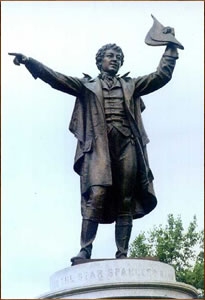De Amerikaanse dichter en advocaat Francis Scott Key werd geboren op de plantage Terra Rubra bij Frederick (Maryland) op 1 augustus 1779. Hij was getuige van het bombardement van Fort McHenry in Baltimore tijdens de Oorlog van 1812. Key was aan boord van een Brits oorlogsschip om een vriend te bevrijden die was beschuldigd van het beschermen van Britse deserteurs. De Britse commandanten kwamen overeen beide mannen vrij te laten, maar om veiligheidsredenen werden ze nog een nacht vastgehouden terwijl de Britse vloot het fort bestormde. De volgende dag schreef Key een gedicht met de titel The Defense of Fort McHenry, beter bekend als „The Star-Spangled Banner”. De muziek waarop het werd gezet was van een populair lied uit die tijd (to Anacreon in Heaven), geschreven rond 1800 door John Stafford Smith. Het werd aangenomen als het volkslied van de Verenigde Staten op 3 maart 1931. In de meeste gevallen wordt alleen het eerste couplet gezongen.
The Star-Spangled Banner (fragment)
O! say can you see by the dawn’s early light,
What so proudly we hailed at the twilight’s last gleaming,
Whose broad stripes and bright stars through the perilous fight,
O’er the ramparts we watched, were so gallantly streaming.
And the rockets’ red glare, the bombs bursting in air,
Gave proof through the night that our flag was still there;
O! say does that star-spangled banner yet wave,
O’er the land of the free and the home of the brave?
On the shore, dimly seen through the mists of the deep,
Where the foe’s haughty host in dread silence reposes,
What is that which the breeze, o’er the towering steep,
As it fitfully blows, half conceals, half discloses?
Now it catches the gleam of the morning’s first beam,
In full glory reflected now shines in the stream:
‘Tis the star-spangled banner, O! long may it wave
O’er the land of the free and the home of the brave.

Francis Scott Key (1 augustus 1779 – 11 januari 1843)
Monument in Frederick
